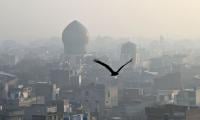The World Health Organisation said on Monday that the number of new coronavirus cases registered in the past day in China was far lower than in the rest of the world.
"In the last 24 hours there were almost nine times more COVID-19 cases reported outside China than inside China," World Health Organisation chief Tedros Adhanom Ghebreyesus told reporters in Geneva.
To date, more than 3,000 people have died from the new virus, while nearly 90,000 have been infected around the world, according to AFP’s latest toll based on official sources. In China, where the deadly new virus first appeared last December, the number of new cases being registered each days is meanwhile continuing to decline, with only 206 new cases reported to WHO on Sunday.
That marks the lowest number of daily cases reported since January 22, Tedros said, adding that all but eight of those cases were reported in Hubei province -- the epicentre of the outbreak. Outside of China, however, 8,739 cases have now been registered across 61 countries, including 127 deaths, according to WHO’s latest count.
Tedros said a "window of opportunity" remains to contain the outbreak, noting that "more than 130 countries have not detected any cases yet". In the countries that are seeing cases, he said the situations in South Korea, Iran, Italy and Japan are currently "our greatest concern".
Iran reported 12 more deaths on Monday, raising the country’s toll to 66, the second biggest after China. A WHO mission to support the Iranian response to the outbreak arrived in the country on Monday, bringing with it "protective equipment to support over 15,000 health care workers".
The team also brought "laboratory kits enough to test and diagnose nearly 100,000 people," WHO said. South Korea, the biggest nest of infections outside China, reported nearly 500 new cases on Monday, raising its total past 4,000.
Half of South Korea’s cases are linked to a sect whose leader apologised on Monday for the spread of the disease. Tedros said he was encouraged to see that most of the South Korean cases were linked to "five known clusters", indicating "that surveillance measures are working." Meanwhile, Nasa satellite images show a dramatic fall in pollution over China that is "partly related" to the economic slowdown due to the coronavirus outbreak, the space agency said.
The reduction in nitrogen dioxide (NO2) pollution was first noticed near Wuhan, the epicentre of the outbreak, but eventually spread across China, according to Nasa scientists who examined data collected by their and European Space Agency satellites.
Maps comparing NO2 concentrations showed a marked decline between January 1-20, before a sweeping quarantine was imposed on Wuhan and other cities, and February 10-25. "There is evidence that the change is at least partly related to the economic slowdown following the outbreak of coronavirus," NASA’s Earth Observatory said in a statement.
Chinese authorities have taken drastic steps to contain the virus, curbing the movement of people, temporarily closing factories across the country and quarantining central Hubei province, a key industrial region where the epidemic first appeared.
NO2 is a byproduct of fossil fuel combustion in vehicles and power plants and can cause respiratory problems, such as asthma. "This is the first time I have seen such a dramatic drop-off over such a wide area for a specific event," Fei Liu, an air quality researcher at Nasa Goddard Space Flight Centre, said.
The 2008 global financial crisis saw a decrease in NO2 over several countries but it was a gradual fall, she said. This year’s fall came during the Lunar New Year, when factories and businesses close, but researchers believe the decline is far greater than could be attributed to the holiday period.
NO2 concentrations over eastern and central China were 10-30 percent lower than what is normally observed over the time period. And there has not been a rebound in levels after the holiday.
"This year, the reduction rate is more significant than in past years and it has lasted longer," Liu said. "I am not surprised because many cities nationwide have taken measures to minimize spread of the virus."
A separate study in February found China’s carbon emissions had dropped by least 100 million metric tonnes in the previous fortnight -- nearly six percent of global emissions during the same period last year.
According to a study by the Centre for Research on Energy and Clean Air in Finland, the rapid spread of the coronavirus led to a drop in demand for coal and oil, resulting in the emissions slump.
An aerial view shows the Bibby Stockholm barge moored at Portland Port, near Poole, Britain on August 7, 2023.—...
Chinese Defense Minister Dong Jun attends the Shangri-la Dialogue in Singapore on June 2, 2024. — ReutersBEIJING:...
Elise Stefanik, a Trump loyalist congresswoman and Lee Zeldin, Trump's pick to lead the Environmental Protection...
A representational image of a burglar. — X/@merriamwebstar/FileTOKYO: Japanese police said on Wednesday that they...
Myanmar's Commander in Chief Senior General Min Aung Hlaing salutes as he attends an event marking Martyrs' Day at...
A Ukrainian service member attends military exercises during drills at a training ground, amid Russia's attack on...







